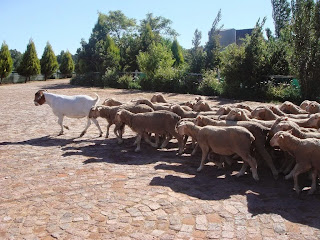A powerful King with a beard.
In "Goat Hall", there is a powerful King with a beard, this time called Jesus, who is surrounded by warring subjects. One of these is Peter, who although revered nowadays as a saint and martyr, was in fact the first Catholic, and therefore automatically "not respectable". (Apologies to our readers from other denominations: you may wish to point out that Peter was also the first Anglican, the first Lutheran, the first Methodist, and the first Calvary Chapel worshipper. Clearly, he was not the first Baptist: that was John.)
The hero of Hilary Mantel's "Goat Hall" is of course Judas Iscariot, who most historians think of as one of the most repulsive villains of that time. Luckily Dame Hilary is there to put them straight: she points out that he was on excellent terms with the King, and on one memorable occasion gave him an affectionate kiss.
Proof that Judas was on good terms with the King.
After the Resurrection, Peter disappears to an obscure administrative position in Rome, where he eventually meets his come-uppance. The novel focuses more on the fate of its hero Judas. Did he hang himself, or was he murdered? Is the reference to his bowels gushing forth a sign that he was poisoned by jealous Catholics?
It is confidently expected that the book, and its dramatization as a TV series, together with "Goat Hall" souvenir mugs and tee-shirts, will make at least 30 pieces of silver for Dame Hilary's MANTELTRASH® company; moreover, she will no doubt win even more ludicrous prizes and awards on the strength of it.
So all that remains is to explain the title of the book.
A Judas goat leading lambs to the slaughter. Or Hilary Mantel leading her readers.




Eccles, you have restored my faith in that nasty Catholic, St Thomas More.
ReplyDeleteI was at Windsor Castle today and noticed in St George's Chapel a poster claiming that Henry VIII was a pious king. . . The poster must have been written by Hilary Mantel
ReplyDelete